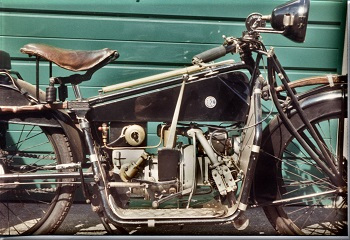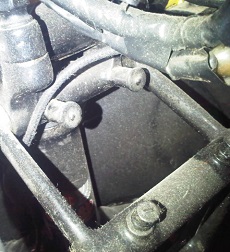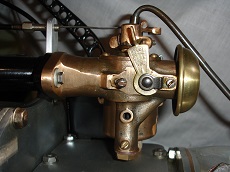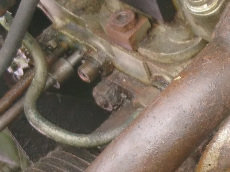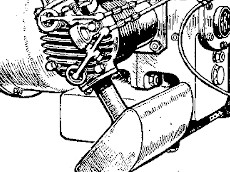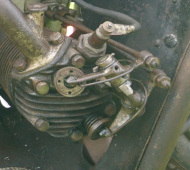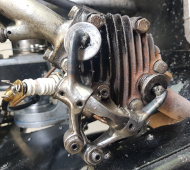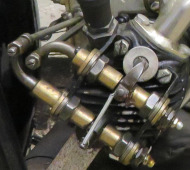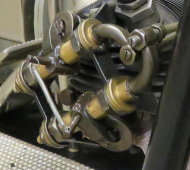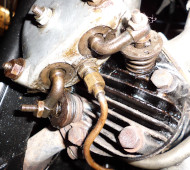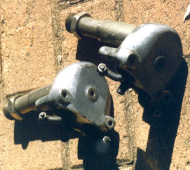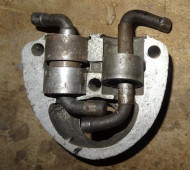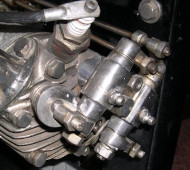Chapter 1
The modern appellation Superbike conjures up for me, a vision of a Tupperware-encased projectile that can go from zero to the ton to zero in about 50 yards.
The Sopwith ABC qualifies differently: perhaps as a Wonderbike. In 1919, it had an overhead valve flat-twin engine with light-alloy pistons, set transversely in a wide duplex-cradle frame. A four-speed, in-unit gearbox took up the drive from a flywheel-clutch. Bevel gears turned the driveline through 90⁰, for final transmission by chain, via a cush-drive hub, to the back wheel. Rear suspension by a swinging fork was featured, controlled by leaf springs. Drum brakes were provided at the rear and front ends. The gearbox casting included an integral dynamo housing, with internal drive-gear. There was a centre-stand, and sheet-steel shielding of the power unit, and of the rider’s lower person, from road-muck: of which there was plenty in 1919. Performance was brisk rather than brutal: the rather fragile 398 cc’s could only be worked so hard, although a kerbside weight of 220 lbs helped considerably.
Really, the overall ABC specification wasn’t matched by another machine for nearly 30 years, until the advent of the post-war Douglas, in fact. Apart from the avoir-dupois, it can be argued that the biggest difference between Douglas and ABC was Designer Halliday’s apparent obsession with torsion bars, and Designer Bradshaw’s evident predilection for leafsprings!
Chapter 2
A distinctive feature of the girder forks fitted to the ABC was that they were controlled by leaf springs. A less-obvious distinction lay in the details of their spindles.
Many fork-manufacturers of the time used hardened steel spindles that ran directly in the surrounding steel of the forks. Wear was shared about equally between the spindles and their housings: how their owners dealt with this is not recorded, but if bushing had been employed, the bushes would probably have been press-fits in their housings, and the new (?) spindles would have turned within them.
ABC fork spindles were, to say the least, spindly, at only 5/16” diameter! Too much spindle wear could have been disastrous. I believe that Designer Bradshaw had weight-saving in mind when he dimensioned them, but also, fortunately, safety. To ensure that his thin spindles didn’t become any thinner, he bushed them, but in such a way that the outsides of these bushes provided the bearing surfaces! Not a lot of people know this, perhaps not even all ABC owners.
Chapter 3
Claudel Hobson was a well-known maker of carburettors for early aircraft engines. Perhaps through the Sopwith Aviation connection, or because Bradshaw, G., had designed several aero engines, Claudel Hobson was persuaded to make a carb. for the ABC motorcycle, designated the HC-4. This instrument today would, I think, tick many of the boxes for acceptance as a piece of Modern Art: it was an irregularly (but very purposefully) shaped, one-piece bronze casting of considerable complexity, whittled out to accept the working bits. The foremost of these lived in a cylindrical mixing-chamber, as per an Amal slide, except that it didn’t Slide, it Rotated: about its vertical axis. An internal drillway from the float chamber conducted the essence to the bottom end of a tall tubular main-jet, through which it percolated upwards to meet the breeze towards the cylinders. A side-lever mounted on the inlet choke-tube was reminiscent of the operating handle of a ship’s engine-room telegraph: aft for ‘start’, ‘midships for ‘run’, and forrard for ‘weak’.
This single carb. was connected to the two cylinder heads via a tee-piece, around which was fitted a pressed metal muff, fed from an exhaust pipe bleed. This was intended to prevent carburettor icing, but, being on the exit side of the carb., not the intake side, wasn’t bound to be a runaway success. About all it did, in fact, was to rot out the mild steel tee-piece, and the muff itself, with condensate from the exhaust gases!
Chapter 4
That the engine is lubed on a Total-Loss style system, no-one disputes. Beyond that, theories and understandings on the details of its working vary…
The most persistent version seems to be that the mean internal crankcase pressure is held slightly negative, and that this depression draws oil from a compartment in the fuel tank through a regulator valve and sight-glass, down to the engine. All I can say is, not on mine! Piston blow-by furnishes quite a healthy positive crankcase pressure, or it would, if there weren’t so many holes for it to escape: round the magneto’s drive-shaft for instance, to say nothing of the tappets and rear main bearing.
Oil enters the crankcase through a small non-return valve. A breather pipe set high on the crankcase wall, equipped with a similar exit-only valve, is supposed to control the crankcase internal pressure! There is evidence that some prototype (racing?) engines featured a wet sump with an oil circulation system, but production engines weren’t fitted with any sort of pump at all, nor a sump.
A hand-pump set in the oil compartment works only on its up-stroke, and is not fitted with a spring, return or otherwise: it is intended only to prime the system. Once primed, oil syphons up through the pump itself, regulator valve and sight-glass, and on down to the engine by gravity. It’s a bit hit and miss (meaning, difficult to regulate), but usually works well enough.
Chapter 5 “How Long is Your Reach?”
This refers to your choice of sparking plugs, not the span of your arms.
In 1919, ABCs were fitted with 18 mm. plugs, of course. These days, the choice of heat rating, and in particular of length that comes with 18 mm. plugs, is rather limited. What the reach of plugs fitted as original equipment to ABCs was, I don’t know: but the spare-parts list of the day included “extra long KLG plugs”, at 6/- each.
Although the combustion chambers of the ABC were surely close to ideal, with shallow concave piston crowns facing shallow part-spherical head recesses, thus providing smooth and compact detonation-dromes, they were let down somewhat by the overly-long, and typically partially masked, sparking plug holes. The electrodes of a common or garden, short-reach 18 mm. bougie, come nowhere near the reaction chamber: which can hardly promote snappy torching of the mixture.
A way forward is to fit 14 mm. plug adaptors. These are just tubes, threaded inside and out, and can conveniently be made from old 18 mm. plug bodies, turned off and whittled out to suit, and tapped M14 x 1.25 mm. pitch. The adaptors need not be ‘full length’. They can be notched at one end for (large) screwdriver-engagement, and anchored with a dab of Loctite. 14 mm. plugs will seal quite happily on the old 18 mm. seating areas. The choice of long-reach 14 mm. plugs is huge, and to the point, its electrodes will be a lot closer to the action!
Chapter 6, “Rockers and Mods”
A noteworthy feature of the Sopwith ABC is the variety of after-market valve-rocker systems that were produced and fitted in considerable numbers. The rocker-gear provided by the factory must have rapidly acquired a very dubious reputation indeed! It consisted of a single forged-steel finger- post on each cylinder head, which supported both rockers, and which was attached to the head by two bolts through its small foot. Probably it was rigid enough at modest engine speeds, but might well have gone into a blur at, for instance, a missed gearchange. How many pushrods were really despatched into adjacent hedges as a result of this will never be known, but anyhow, such alleged pushrod-prodigality was almost certainly the reason for the spawning of so many alternative rocker systems.
The cylinder heads were each attached to their cylinders by six equi-spaced ¼“ BSF through-bolts. Each original rocker-support used just one of these: its second bolt was into the head itself.
The soundest of the after-market options were the Inglis and the Jarvis, which were each anchored down to four of the six bolt-holes (two opposite pairs) via spacers and longer bolts. This provided a stable platform for the cast aluminium and pressed-steel rocker frames, respectively. (The actual rockers used by Inglis and Jarvis looked suspiciously similar).
The Taylor-Young offering was classily enclosed by a polished cast-aluminium cover. Evidently the makers were taking no chances with escapee pushrods, as these were enclosed too! However, it was all anchored via only two of the headbolts.
The BEW (Brooklands Engineering Works) set shared a similar fixing pattern, but the Grubb was anchored exactly as per the original set. At least its body was much sturdier than the original. The BEW was characterised by a cast-bronze body, and the Grubb (as per the Brum Mausoleum machine) by clearance-adjustment screws at both ends of each rocker!
The overall significance of all this is perhaps not so much the marginal adequacy of the original rocker gear, but the high regard in which so many after-market suppliers evidently held the ABC.
Chapter 7
“What would you get if you crossed Steinway and Son with the flat-pack furniture industry?” A parallel answer might be, the Sopwith ABC motorcycle…
Although there is evidence of some minor modifications to Bradshaw’s ambitious and demanding design, renowned aircraft manufacturer Sopwith generally tried to live with the original concept, and characteristically, to compensate for weak or unsound features with Excellence of Execution and Attention to Detail. Certainly, the qualities of casting and welding and machining of the components, and of their assemblies, and of the materials used, are peerless.* Proof of the Quality Control of all manufacturing can still be seen today: Sopwith must have had a small army of inspectors, each with his own little hammer and set of stamps. Even nuts and bolts didn’t escape scrutineering, and the bigger and more complex assemblies carry as many impressed hieroglyphs as many an Egyptian temple.
The downside of all this was the inevitable cost, and slowness of production. With greater capital investment, and in the hands of a sizeable automotive manufacturer, the venture might have been a runaway success. Except that, only such as an aircraft company would ever have been naive enough to take such a project on!
* The hapless kick-starter was admittedly an exception to this. However, I prefer to regard it as an unfortunate afterthought, only fitted to later machines.
Writer’s Footnote: the intention of these Chapters has been to raise and maintain a level of interest in, and awareness of the ABC marque, leading I hope to a bumper outing of these rare and typically-underrated machines.
In the meantime, my thanks are due to Present and Past VMCC ABC Marque Specialists Keith Sams and Alan Redman, and to ABC Registrar David Hales, for proof-reading the Chapters, and preventing major goofs!
Written for, and originally appearing in, the VMCC Journal, January to July, 2013: re-presented here (with improved photos) to popular request.
Paul Button

